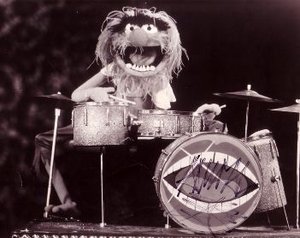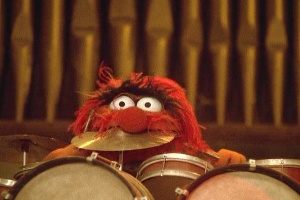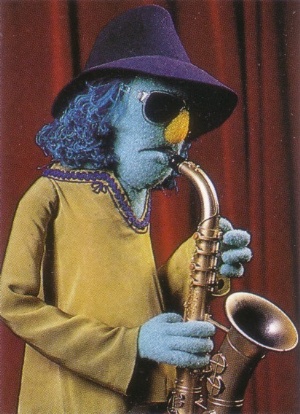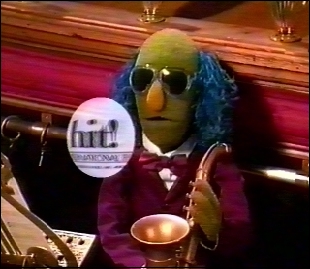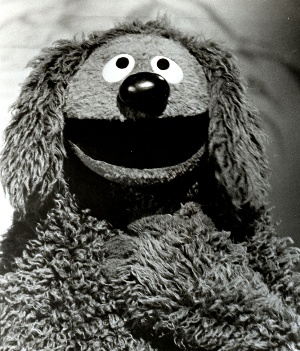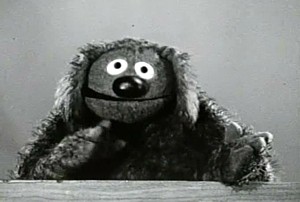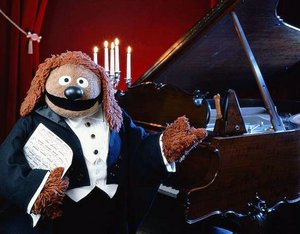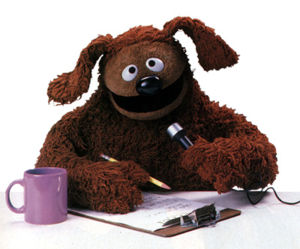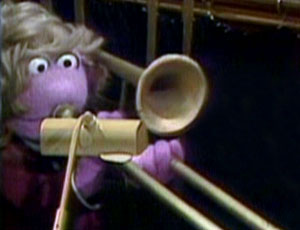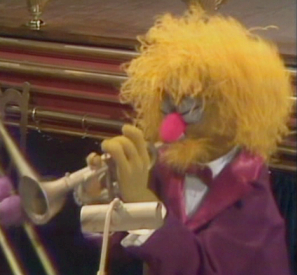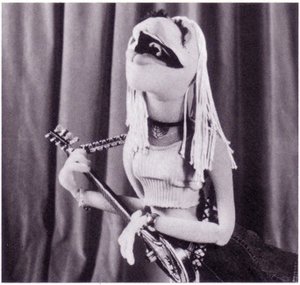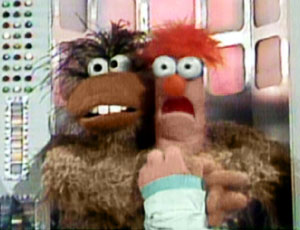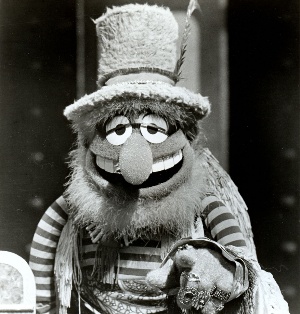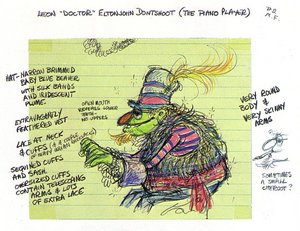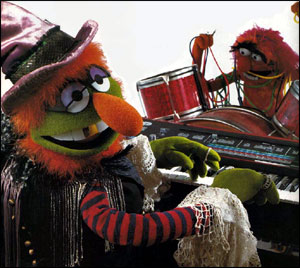Remember watching the Muppet Orchestra? Everyone loved animal and Rowlf the piano player. It’s not uncommon for drummers to yell like Animal (Muppet drummer) from the drums when they’re letting loose. Of course my favorite was Rowlf the piano player; how did he play so well with those big paws? One of the great mysteries of life.
I bet you don’t remember all the musicians in the Muppet Orchestra and in the muppet rock band Electric Mayhem. Here’s a little refresher….
NIGEL THE CONDUCTOR
Nigel debuted in The Muppet Show: Sax and Violence pilot as the show’s host. For The Muppet Show proper, Nigel had a less high profile assignment, conducting the Muppet Orchestra for the entire run of the series. He also appeared onstage from time to time, such as in the Sax and Violence and Library sketches. He was seen rarely afterwards, only making a few appearances in The Muppets: A Celebration of 30 Years and A Muppet Family Christmas.
Nigel has eyelids, which is unusual for a Muppet whose eyes are on the top of his head; a view from behind (as seen for instance in the Muppet Show end credits) reveals that they are perched on top of his eyes and are not connected to the rest of his body.
In the pilot and in most of his Muppet Show appearances, Nigel was played by Jim Henson, with John Lovelady performing the character a few times.
FLOYD PEPPER – BASS GUITAR
Floyd Pepper is the bass player for The Electric Mayhem band on The Muppet Show. He first appeared in the 1975 pilot The Muppet Show: Sex and Violence. One of the more vocal band members, Floyd’s hip sarcasm is often directed at other Muppet Show regulars, particularly Miss Piggy. Frequently paired with Janice, Floyd also has a certain influence on Animal, or at least as much as anyone can. In picture books such as The Case of the Missing Mother, or certain installments of the Muppet comic strip, Floyd is practically Animal’s keeper, pulling his chain and looking after him.
At a Museum of Television and Radio seminar in 1992, performer Jerry Nelson said:
I always thought of Floyd as a character who had probably been a beatnik first, and then — just like real life — probably been a beatnik, and then he was into jazz and poetry, and then he probably went along with the chase into rock and roll, because he needed a job. He drew the line at punk, as I probably did myself, I think. That’s why I can relate to Floyd, I guess, because he’s all those things.
On The Muppet Show, Floyd regularly appeared backstage and interacted with characters outside of The Electric Mayhem. He has also been involved in the plot of a few episodes.
In episode 123, Floyd led the band in quitting because they didn’t like the theme song. Floyd later told Kermit that the band would stay if he wrote the theme song. However, Kermit did not like this new theme (Fugue for Frog), and it was never explained on the show how Kermit was able to get the band to stay. They just appeared in the next episode, as if there was never any conflict at all.
In episode 201, Floyd was very active backstage, as the band decided to make Fozzie Bear an honorary hip person because he planned on making “Lullaby of Birdland” the closing number, and he gave Fozzie a pair of shades for being hip. However, after the performance, the band took a vote and decided that Fozzie was no longer hip, and Floyd took Fozzie’s shades away.
In episode 305, Floyd was chosen to appear in the Muppets performance of “Camelot”, in a role that Floyd wasn’t too thrilled to be playing.
In episode 407, when Dudley Moore decided to have a music-making robot, M.A.M.M.A., provide the music for the show, the band was against this, and Floyd did most of the talking for the band.
In episode 506, Floyd portrayed the role of the Catepillar in the Muppets performance of Alice in Wonderland.
Some of Floyd’s songs include “Ain’t Misbehavin'” and “New York State of Mind”.
Floyd’s name is a play on two band names; namely Pink Floyd (his name is Floyd and he’s pink), and the Beatles (his last name and the jacket he wears are a homage to Sgt. Pepper’s Lonely Hearts Club Band)
ANIMAL – DRUMS
You don’t mess with Animal. He eats glass, man.
– Frank Oz [1]
Animal first appeared in the 1975 pilot, The Muppet Show: Sex and Violence, chained up in a basement cell when he wasn’t onstage performing with The Electric Mayhem. He later became a main character on The Muppet Show, and his unrestrained style has made him popular with young people for decades.
Animal is a crazed drummer with three styles of music — loud, louder, and deafening. He speaks in a guttural shout, often repeating a few simple phrases, such as “BEAT DRUMS! BEAT DRUMS!” or “WO-MAN!” In relatively calmer moods, he is capable of more coherent conversation, but these instances are infrequent.
Frank Oz says that he had his character down to five words: Sex, sleep, food, drums and pain.[2] Occasionally, two of those essentials, food and drums, are interchangeable. In The Muppet Movie, Dr. Teeth had to remind Animal to beat, and not eat, his drums. In The Muppet Show episode 110, when asked by Kermit if he preferred drumming to food, Animal replied that drums are food, and started eating his drum kit.
Animal’s family life is generally non-existent, and outside of the band, the Muppet Show troupe, and women in general, he has no other relationships. A significant exception is depicted in the book The Case of the Missing Mother, which reveals the existence of Animal’s mother, LaVerne. LaVerne is also a drummer, and it’s implied that percussion skills are a family trait.
* 1 Movies
* 2 Notable Performances
* 3 Popularity
* 4 Casting History
* 5 Sources
Movies
Animal has had roles in all of the Muppet movies. In The Muppet Movie, he ate Dr. Bunsen Honeydew’s Insta-Grow Pills, causing him to grow ten times his size and scare away Doc Hopper. He also appeared in The Great Muppet Caper, The Muppets Take Manhattan, The Muppet Christmas Carol, Muppet Treasure Island, Muppets From Space, It’s a Very Merry Muppet Christmas Movie and The Muppets’ Wizard of Oz.
In Muppets From Space, Animal was part of the main cast, as opposed to just being part of The Electric Mayhem like in all of the other movies.
Notable Performances
Animal has performed a number of solos on The Muppet Show, including “Sweet Tooth Jam”, “Wild Thing”, and “A Foggy Day”.
When drumming legend Buddy Rich appeared on The Muppet Show, one sequence featured a “drum battle” between Rich and Animal in homage to the legendary face-off album between Rich and his contemporary Gene Krupa.
Although Animal battled Buddy Rich, in an earlier episode, episode 110, it was mentioned that Buddy Rich was one of his idols during an interview that Kermit gave Animal. Also during this interview, Animal revealed that he had been playing the drums for five years, which would mean that he’s been playing the drums since 1971.
One of Animal’s most memorable performances with a guest star was in episode 105, in which he wildly played the drums in Rita Moreno’s number “Fever”. Other guest stars who have had scenes with Animal include Lou Rawls, Leo Sayer, James Coburn, Harry Belafonte, and Kaye Ballard.
Popularity
Animal is probably the most popular member of The Electric Mayhem. He has certainly been included in more merchandise than the rest of the band. He was also the only member of the band to be included regularly on Muppet Babies.
Animal was the mascot of the U.S. snowboarding team for the 1998 Winter Olympics in Nagano, Japan. Animal made a television appearance in Nagano with CBS reporter Kennedy, during which she stapled his feet to a snowboard.
ZOOT – SAXOPHONE
Zoot is the the balding, blue-haired saxophone player for the Electric Mayhem. According to his performer Dave Goelz, “Zoot is just a fifty-year-old burnt-out musician.”
Zoot first appeared with his bandmates in The Muppet Show: Sex and Violence before securing a regular gig on The Muppet Show, where he played both in the Muppet Orchestra and with the Mayhem. He has also appeared in every Muppet movie, the most recent being The Muppets’ Wizard of Oz.
One of Zoot’s trademarks is blowing small notes of music at a time. He notably blew the final note of “The Muppet Show Theme” in the closing credits on every episode of The Muppet Show. Although most of his appearances were with the Electric Mayhem, Zoot was more prominently featured as an individual in the early episodes, appearing with Juliet Prowse in a blackout on episode 101, and playing a reluctant duet with Mahna Mahna in “Sax and Violence” on episode 102.
Zoot was also more talkative during the first season, but soon started speaking less, often expressing himself purely with music. Dave Goelz explained that “I found that when the writers gave Zoot lines to speak, I would always try to give them away to other characters, because I didn’t know what to do with him. Maybe that helped to define the character. Perhaps it’s best that he’s so non-verbal.”[2] Thus, Zoot’s proclivity towards speaking more in the earlier episodes may have been due to the fact that Jerry Nelson, who played Zoot’s more animated bandmate Floyd was not available for tapings of The Muppet Show’s first episodes.
Evolution
Throughout the years, the Zoot puppet has been redesigned several times, his skin changing from gray to blue to green, the texture from exposed foam to fleece and back again, and his nose from green to yellow. Zoot’s trademark shades, his bald spot, and his long, blue hair have always stayed with him, though.
ROWLF THE DOG – PIANO
Performer:
Jim Henson • (1962 – 1990)
Bill Barretta • (1996 – present)
Rowlf the Dog was the first Muppet to reach national stardom as a cast member of The Jimmy Dean Show from 1963 to 1966. He later went on to serve as the resident piano player on The Muppet Show, also playing the silly surgeon Dr. Bob on the recurring sketch “Veterinarian’s Hospital”.
Origins
Early Rowlf
Early Rowlf
Rowlf first appeared in 1962 in a series of Purina Dog Chow commercials. He was paired with Baskerville the Hound in a series of ads which aired from 1962 to 1963. Rowlf also appeared in an ad for Esskay Meats during the same time period.
Rowlf was the first Muppet built by Don Sahlin. Unlike most of the early Muppets, he was designed as a live-hand Muppet; he was also one of the first non-abstract Muppet characters, built to resemble a dog. According to Henson’s original notes, other names considered for the character were Barkley, Woofington, Baskerville, Barkus, Howlington, Waggington and Beowolf.
Rise to Fame
Rowlf rose to stardom as Jimmy Dean’s sidekick on The Jimmy Dean Show. The show ran from 1963 until 1966. Rowlf the Dog was a regular on the show, and was billed as Jimmy’s “ol’ buddy.” Between seven and ten minutes of every show were devoted to a spot with Rowlf and Dean. Many of the comedy sketches ended with the two singing a duet together. Rowlf’s tenure on The Jimmy Dean Show allowed Jim Henson to develop the character over a period of time.
Rowlf continued to star on variety shows, hosting Our Place and appearing in several episodes of The Mike Douglas Show. He also hosted the 1968 special Muppets On Puppets.
Rowlf appeared in the 1965 Wilson’s Meats Meeting Film, as an example of the Muppets’ exposure (“I’m the Muppets’ big loveable shaggy dog Rowlf, from ABC’s The Jimmy Dean Show!”). He also appeared in the Sesame Street pitch reel, explaining the concept and production process to a wary Kermit, as both characters were the most familiar Muppets at the time. He also appeared in Sesame Street season one, making a cameo appearance in the “Song of Nine.”
Rowlf appeared in brief celebrity cameo-esque roles in the two Muppet Show pilots, The Muppets Valentine Show and Sex and Violence.
When The Muppet Show debuted, Rowlf was a part of the cast. Rowlf was assigned the role of resident pianist (abandoning his ukulele skills from The Jimmy Dean Show). At the piano, Rowlf would often perform classical music, and sing solos or duets. Rowlf also performed in the pit orchestra and sometimes sat in with the Electric Mayhem. Despite Rowlf’s established fame among American audiences, a majority of his musical numbers were not seen in the US, as the sketches and songs starring Rowlf dominated the list of UK Spots.
Apart from displaying his musical talents, Rowlf continued his comedic style from The Jimmy Dean Show with his customary puns and gags – most notably as Dr. Bob, “the quack who has gone to the dogs,” in “Veterinarian’s Hospital,” or with a female partner in the recurring At the Dance segments. During the first season, Rowlf also appeared in two Poetry segments. Rowlf would occasionally take on other character roles in the on-stage productions – including Sherlock Holmes and a Western bar piano player. Whether in featured roles or non-speaking cameos, Rowlf appeared in 89 of the 120 episodes of The Muppet Show.
Due to Rowlf’s musical skill, it is sometimes incorrectly assumed that he was a part-time member of The Electric Mayhem Band. Although Rowlf played in the orchestra and back-up on several numbers with musicians in the Mayhem band, Rowlf only accompanied the Electric Mayhem three times: in episode 424, in episode 513 and at Fozziwig’s Christmas party in The Muppet Christmas Carol. In fact, when the Electric Mayhem walked out over the apparent lameness of The Muppet Show theme song in episode 123, Rowlf was the only musician left. As a result, Rowlf had to play the closing theme single handedly.
In 1985, Rowlf hosted two hour-long video compilations of The Muppet Show. In Rowlf’s Rhapsodies with the Muppets, Rowlf sat at his piano and presented a compilation of his best numbers and other songs from The Muppet Show. In Country Music with the Muppets, Rowlf rented a barn and hosted his own country music program while showing clips from the show.
Rowlf was prominently featured in The Muppet Movie as a piano player at The Terrace Restaurant, where he first meets Kermit. When Kermit is down, Rowlf share his motto in life, a motto even he can’t follow – “stay away from women.” The two sing “I Hope That Somethin’ Better Comes Along”. An original draft of the script describes the song as “a sad/funny little duet based on the old ‘can’t live with ’em, can’t live without ’em’ theme, designed to allow for some good harmony howling from Rowlf.”
The song featured a rare pairing of characters, as Jim Henson virtually performed a duet with himself. In order to achieve the effect, the vocals of the two characters were recorded separately by Henson and then combined.
Rowlf soon joined Kermit and the rest of the gang on their way to Hollywood. Before joining the Muppets, Rowlf’s life was simple – he lived alone, would “go to work, come home, read a book, have a couple of beers, take [himself] for a walk and go to bed.” While in the desert, Rowlf played harmonica as Gonzo sang “I’m Going to Go Back There Someday” (while Fozzie played ukulele). Rowlf served as the film’s cameraman in the finale, as the Muppets prepare to shoot their movie.
Rowlf appeared on the piano in the promotional special The Muppets Go Hollywood, accompanying Johnny Mathis as he sang “Never Before, Never Again.”
In The Great Muppet Caper, Rowlf was a resident of the Happiness Hotel. He played piano during the song “Happiness Hotel” and commented on the chambermaids, bugs, and lice. He joined the Muppets on their quest to thwart Nicky’s plot to steal the Baseball Diamond (accounting for the whoopie cushion, which he thinks is on the bus). Rowlf saves the day with his bilingual ability to speak dog as well as English. He is able to reason with Henderson’s attacking guard dogs at the Mallory Gallery (a skill he would use again in A Muppet Family Christmas to communicate with Sprocket).
In The Muppets Take Manhattan, Rowlf was a supporting player, co-starring in Manhattan Melodies. As the gang disbands, Rowlf leaves New York on a bus headed to Delaware. Rowlf displays cinematic range as the conflicted manager of a dog kennel, looking after Mr. Skeffington’s dog Snookums and other canine tenants. When Rowlf gets the news that the show is on, he excitedly returns to the Big Apple, bringing along a host of Muppet dogs from the kennel.
A baby version of Rowlf appeared in Miss Piggy’s fantasy, I’m Gonna Always Love You. The young pup played piano, sang along, and abstractedly hammered away at a Big Bird doll. Baby Rowlf was also part of the regular cast of babies in the animated seriesMuppet Babies. Baby Rowlf’s role was of course that of the nursery’s resident musician, often leading the others into on-the-spot songbreaks, with his ever-present baby piano. His voice in the animated program was performed by Katie Leigh.
On The Jim Henson Hour, Rowlf appeared in a series of sketches where he portrayed the character Merlin in “Merlin the Magician, MD.”. The sketches (seen in episode 102 and 107) were similar to his Dr. Bob days in Veterinarian’s Hospital, but with a medieval, magical twist. The wizard Merlin would use his magic to cure people’s medical problems, making jokes and slinging puns all the while. In one sketch, Rowlf is turned into musical icon Elvis Presley.
Rowlf also narrated the film noir special Dog City, which aired as part of the series. The special features an all new cast of new Muppet dogs; however, Rowlf (the only pre-established Muppet present) is there as the audience’s guide, and is the only character to break the fourth wall.
Rowlf would again be teamed with a group of Muppet dogs in the tenth episode’s “Secrets of the Muppets” special, presiding over a meeting of the O.M.D. (Organization of Muppet Dogs) as President.
John Denver and Rowlf sang “Have Yourself a Merry Little Christmas” in A Christmas Together. The duet was also featured on the conjunctionally released Christmas album.
Rowlf appeared with the Muppets on The Merv Griffin Show in 1983. There, he performed his renditions of “Down Memory Lane” and “You and I and George” while at the keys of a piano
Rowlf subsequently appeared in the special Rocky Mountain Holiday. John Denver takes Rowlf on a wild plane ride, performing one stunt after another, in order to cure Rowlf’s hiccups. In another scene, Rowlf relaxed on an inner tube in the river, until Gonzo popped the inner tube (and tried to break a world record, “Longest time underwater with a dog sitting on you”).
In A Muppet Family Christmas, Rowlf chased the truck all the way to Emily Bear’s house. Once there, Rowlf made himself at home, communicating with Sprocket, playing “Sleigh Ride” on Emily’s out-of-tune piano, and joining in the festivities.
Rowlf hosted his own play-along video, Sing-Along, Dance-Along, Do-Along, in which he taught viewers how to do a variety of musical activities.
Rowlf also appeared in The Muppets at Walt Disney World. In the special, Rowlf was captured by the Walt Disney World pet care center manager, as Rowlf had no owner or tags. While detained, he performed “live from the detention hall of the Disney World Pet Care Center” with the other dogs.
On May 4, 1990, Rowlf was a guest on The Arsenio Hall Show. When Rowlf came out, he immediately pointed to Arsenio and remarked, “Son of a bitch!” After the audience’s hysterics died down, Rowlf added, “Coming from a dog, that’s a compliment.” The show marked Jim Henson’s last public performance of Rowlf the Dog – Henson died 12 days later.
An all-Rowlf album, titled Ol’ Brown Ears is Back, was released by BMG Records in 1993. The album featured several songs from The Muppet Show, as performed by Rowlf at the piano with an orchestral accompaniment. Though it wasn’t released until after his death, Henson recorded the vocals in 1984.
Post-Henson
Rowlf dances in Muppets From Space.
Rowlf dances in Muppets From Space.
After the death of Jim Henson, Rowlf continued to appear in Muppet productions, silently (and usually briefly). A rumor arose that the character would be permanently silent as a sign of respect for Jim Henson. As Brian Henson commented on in the audio commentary for The Muppet Christmas Carol, the character continued to appear as a tribute to the character and Henson’s legacy. Still, Rowlf was not recast and kept in the forefront like Kermit, because the Muppeteers didn’t feel there was a suitable and appropriate performer for the task.
Rowlf was featured silently in The Muppet Christmas Carol (playing piano at Fozziwig’s party), Muppet Treasure Island (as a patron of The Admiral Benbow Inn) and Muppets From Space (as a resident of the Muppet Boarding House).
Bill Barretta has since taken over the character and gradually transitioned into the role. Although Rowlf only appeared in one episode of Muppets Tonight, Rowlf uttered his first word since Henson’s passing in episode 102; while playing piano during the closing number, Rowlf exclaims “Yeah!”
Rowlf had several lines of dialogue in The Muppet Show Live in 2001 and also spoke two lines of dialogue (“Hey, Kermit!” and “Yeah! Heh, heh. Oh!”) in It’s a Very Merry Muppet Christmas Movie in 2002. In 2005, however, Rowlf had a 190-word monologue in the second episode of Statler and Waldorf: From the Balcony. Rowlf appeared in the “Keep Fishin” music video for rock band Weezer. Although he’s only briefly seen, Rowlf had a more prominent role in the behind the scenes making-of special that accompanied it, Weezer and the Muppets Go Fishin’.
Additionally, Bill Barretta recorded the vocals as Rowlf singing “The Christmas Party Sing-Along” for the 2006 A Green and Red Christmas album.
Performing Rowlf
Rowlf is a live hand puppet. Jim Henson would usually perform the head (and voice) and left hand, while another Muppeteer (including, at various times, Frank Oz, Jerry Juhl, Jerry Nelson, Louise Gold, and Steve Whitmire) performed his right hand. However, when Rowlf played the piano, Henson would helm the head and the second performer would control both hands on the keys. Steve Whitmire commented on performing Rowlf’s piano-playing hands in a 1999 interview:
One of my favorite things to do, ever, in my career has been to do Rowlf’s hands on the piano, which is something that other people had done, but once I started doing it, I kind of have done it since… It’s the best job in the world for somebody who sort of plays the piano, but would really like to play the piano well…you can approximate what it’s supposed to be and make it look really good.
Derek Scott, musical consultant for The Muppet Show, supplied Rowlf’s pre-recorded piano playing on the program. Rowlf’s fingering was never actually worked to be accurate, yet the illusion was not broken due to careful practice and skill of timing and approximating. Steve Whitmire said that when he was going to helm the hands on the keys he would spend hours learning every nuance of a pre-recorded piano track to make it look believable.
Rowlf’s piano was a dud, the hands could bang the keys with no sound being emitted; instead, the pre-recorded piano track would handle the music. However. in episode 309 Rowlf had to come in and start playing the same piano which guest star Liberace was performing on. Since the number, including Liberace’s actual piano playing, was recorded live, Derek Scott was off camera tickling the ivories while Rowlf mimed the actions on stage. On close inspection of the scene, a viewer can see that Rowlf is actually not touching any of the keys, just banging the air above them so as to not emit any stray sounds and ruin the take.
Although people tend to identify Jim Henson with Kermit the Frog, according to many sources (including Jim Henson: The Works), Rowlf’s laid back and down to earth personality was perhaps the closest to Henson’s real life demeanor and personality. Brian Henson stated in a Muppet Show introduction that “Kermit was my father’s best known character, but a lot of people think he was more like Rowlf in real life…except he couldn’t play the piano as well.”
Casting History
* Jim Henson – from the Purina Dog Show commercials (1962) to The Muppets at Walt Disney World (1990)
* Bill Barretta – from Muppets Tonight (1996) to Present
* Due to his status as the first nationally famous Muppet character, Rowlf was also one of the first commercialized characters. In 1966 Ideal Toys produced a hand puppet Rowlf. The puppet had a hole in his back for performing. Unlike the real Rowlf, the puppet has a felt tongue and a tail.
* The fame of the piano playing dog led to two books of piano sheet music, released under Rowlf’s name – Rowlf’s Very Own First Piano Book and Rowlf’s Very First Book of Classic Themes.
* A backstage poster hanging on the wall of the Muppet Theater gives “Rowlf with his Honkey Tonk Piano” top billing (listed above “Fozzie Bear Stand Up Comedy Act” and “Miss Piggy Song & Dance Routine”)
* Rowlf’s character profile on Muppets.com states that he is a graduate of Ruff Barker’s Obedience & Music School where he majored in “piano playing, punning and fetching.”
* Like most dogs, Rowlf is not the only pup in his litter. Although his family history hasn’t been explored in much detail, his mother Tilly and his nephew appeared with him in early television spots.
* Rowlf’s musical talents, aside from singing and piano playing, include adept mastery of the banjo, bongos, harmonica, harp, pipe organ, synthesizer, violin and ukulele.
CRAZY HARRY – TRIANGLE
Crazy Harry is the pyrotechnic expert on The Muppet Show. An unkempt figure with wild eyes and a mad cackle, he delights in blowing things up. In addition to explosions, he played the triangle bell in the Muppet Orchestra during the first season opening and closing. His finest hour may well have been in episode 306, accompanying Jean Stapleton on the explodaphone for a particularly frantic rendition of “I’m Just Wild About Harry.”
He originally appeared on The Muppets Valentine Show, as Crazy Donald — a reference to Muppet builder Don Sahlin, who enjoyed creating the Muppets’ special effects explosions. His name was changed to Crazy Harry in his second appearance,The Muppet Show: Sex and Violence. His film appearances included, amongst others, The Muppet Movie (as the special effects expert), The Great Muppet Caper (as a resident of the Happiness Hotel), The Muppets Take Manhattan (attending the wedding), and The Muppets’ Wizard of Oz (as one of the Flying Monkeys).
When reruns of The Muppet Show were shown on TNT, a Crazy Harry doll was planned as a gift for employees at the network, but only the head (sans eyes) was produced. A Crazy Harry action figure and a bust were later marketed.
In the UK’s Muppet Show Annual 1977, Crazy Harry is referred to as “Mad Harry”.
TRUMPET GIRL – TRUMPET AND TROMBONE
Trumpet Girl, which is what she was called in the scripts[1], was the female trumpet player from the Muppet Show orchestra. She played the trumpet in the orchestra from the first season until the fourth season. In season five, because of the addition of Lips, she switched to playing trombone (she also had open eyelids during that season).
In addition to being a musician, she was often seen as a chorus girl during the first season. She had a brief line in episode 123, where she was performed by Eren Ozker.
LIPS – TRUMPET
Lips is the trumpet player from The Muppet Show. The character was created for performer Steve Whitmire, to give him his own member of the Electric Mayhem. He debuted in the fifth and final season of the series, and played trumpet for both the Electric Mayhem and the orchestra. Lips also appeared as part of the Electric Mayhem in The Great Muppet Caper, A Muppet Family Christmas, and The Muppet Christmas Carol.
Lips rarely spoke. Steve Whitmire once commented upon Lips’ silence:
I felt great whenever he played the trumpet, and I felt terrible whenever he spoke, because I wanted to do this Louis Armstrong kind of voice, and at that point and time, there was some question about whether or not we would offend African-American people by this white guy doing a black voice as a trumpet player… We might offend people who liked Louis Armstrong. We weren’t sure. I never quite got anywhere with Lips. I’d probably be real comfortable with him now, but at that point I wasn’t sure. I still wasn’t ready to do a character.
Two rare examples of Lips speaking include “Barnyard Boogie”, in which he sings a verse, and the finale of The Great Muppet Caper, where he says “And me!”
Despite his obscurity, Palisades Toys released a Lips Action Figure in 2004.
GUEST ARTISTS
JANICE (Electric Mayhem) – GUITAR
Janice is the lead guitar player in the Electric Mayhem on The Muppet Show. She also portrays Nurse Janice in Veterinarian’s Hospital, along with showing up in various other sketches and sometimes appearing as a chorus member. She was also occasionally seen in the orchestra during the fifth season. She has a very close relationship with the Electric Mayhem’s bass player, Floyd Pepper.
Janice was originally performed by Fran Brill in The Muppet Show: Sex and Violence pilot in 1975, and in the first set of Muppet Meeting Films. Eren Ozker performed Janice in the first season of The Muppet Show. Richard Hunt took over the character in season 2, and gave Janice her familiar Valley Girl voice and attitude.
Michael Frith’s original sketch of the character indicates that she was intended to be a male character, a takeoff on Mick Jagger’s emaciated frame. Her name is probably a reference to Janis Joplin. However, in her final form as performed by Hunt, she bears very little resemblance to either Jagger or Joplin.
Casting History
Main Performers:
* Richard Hunt – from The Muppet Show Season 2 (1977) to The Muppets Celebrate Jim Henson (1990)
* Fran Brill – The Muppet Show: Sex and Violence (1975), Muppet Meeting Films (1975)
* Eren Ozker – The Muppet Show Season 1 (1976-1977)
* Brian Henson – It’s a Very Merry Muppet Christmas Movie (2002), Muppet Party Cruise video game (2003)
Alternate Performers:
* John Lovelady – Julie Andrews: My Favorite Things (1975)
* Matt Vogel – Muppet Race Mania video game (2001)
* Tyler Bunch – The Muppets’ Wizard of Oz (2005)
QUONGO – CYMBALS
uongo the Wild Mountain Gorilla was created for The Muppet Show episode 219, where he teleported back from Africa with a startled Kermit.
He can also be seen in episode 320 throwing coconuts during “Hawaiian War Chant.”
When he appears in a jungle scene performed by Jerry Nelson in episode 324, he’s referred to by Kermit simply as “chimp.”
Quongo received his name in episode 509, where he was booked to wrestle Gonzo. He was performed by Richard Hunt in that episode.
When he appeared in episode 513 to sing “I’ve Got a Lovely Bunch of Coconuts,” he was again performed by Jerry Nelson.
He appeared in a Muppet Meeting Film: “The Five Basic Rules of Selling”, where he got into a struggle with Leo. Here he was played by Frank Oz.
Quongo hitches a ride with the rest of the Muppet gang in “The Muppets Go Hawaiian” View-Master set.
EUGENE – TUBA
Eugene is a blue Whatnot who plays the tuba for The Muppet Orchestra in It’s a Very Merry Muppet Christmas Movie.
When Miss Piggy falls off the stage and into the orchestra pit towards the end of the movie, she lands on Eugene. Although he survives the impact, his tuba isn’t so lucky.
Eugene hopes that Kermit’s love can fix his tuba, and Kermit assures him it will.
DR. TEETH – KEYBOARDS
Dr. Teeth is the leader of the band, The Electric Mayhem. Originally performed by Jim Henson, Dr. Teeth plays the keyboard and is also lead singer of the band. He first appeared in The Muppet Show: Sex and Violence in 1975, and has taken a prominent role in Muppet productions ever since. He is green-skinned and red-haired with, as his name suggests, a large grinning mouth of teeth. He wears a scruffy beard, a fur vest, a striped shirt, and a floppy purple top hat. He has very long arms so additional puppeteers are required to guide them; this design enabled Henson to work the Teeth puppet while another performer acted as Teeth’s “hands” in order to play the keyboard. His introductory lines in The Muppet Movie are: “Golden teeth and golden tones, welcome to my presence.”
Dr. Teeth has been less involved in recent Muppet productions due to Jim Henson’s death. After being performed by John Kennedy, the role of Dr Teeth was briefly taken over by Bill Barretta. He most recently appeared in the webshow Statler and Waldorf: From the Balcony, performed by Victor Yerrid.
He has also appeared in all of the Muppet movies, from his prominent roles in The Muppet Movie, The Great Muppet Caper, and The Muppets Take Manhattan, to his much smaller, often non-speaking roles in The Muppet Christmas Carol, Muppet Treasure Island, Muppets From Space, It’s a Very Merry Muppet Christmas Movie, and The Muppets’ Wizard of Oz.
* Dr. Teeth’s look was inspired by jazz keyboardist Dr. John. Henson’s original sketch for the character appears in the book Jim Henson’s Designs and Doodles. Michael Frith then made a more refined, color sketch of the character, with the heading “Leon ‘Doctor’ Eltonjohn Dontshoot (the Piano Player)” — adding the influence of Elton John (and possibly Leon Russell) to the character. Dr. Teeth’s creative vocabulary is a direct nod to Dr. John.
Casting History
* Jim Henson – from The Muppet Show: Sex and Violence (1975) to The Muppets at Walt Disney World (1990)
* John Kennedy – Muppets On Location (1991), Muppet Treasure Island video game (1996), Muppets from Space (1999), Muppet Race Mania video game (2000), Muppet Party Cruise video game (2003)
* Bill Barretta – Muppet Treasure Island (1996), The Muppets’ Wizard of Oz (2005), A Green and Red Christmas (2006)
* Victor Yerrid – Statler and Waldorf: From the Balcony Episode 9 (2005)
